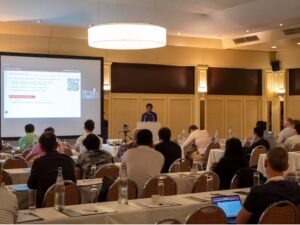On June 12-14, SnT held the International Symposium on Computational Sensing (ISCS), a three-day event focusing on the applications of computational sensing to foster knowledge exchange across different domains. The symposium was held at Hotel Parc Belle Vue in Luxembourg as well as online.
From remote sensing using radars and satellites to medical imaging using light and electrons, computational sensing techniques and theory have become more pervasive than ever. They extend to numerous fields of application, each with their specific sensors and challenges. But often, the configuration used in a certain application can apply to, or even solve, a problem in a completely different domain. Therefore, an exchange in this sense has far-reaching potential, both in academia and the industry.
This is the direction that SnT set out to explore, in line with its interdisciplinary focus, to put Luxembourg on the map as one of the main forerunners in this field. In fact, the symposium tackled subjects that are connected to multiple research groups at SnT, LCSB, and LIST.
The symposium, organised by Dr. Thomas Feuillen from SnT and Dr. Amirafshar Moshtaghpour from The Rosalind Franklin Institute (UK), saw the participation of renowned international experts in the field, with over 50 in-person attendees and featured sessions about topics such as LiDAR, electron microscopy, radar, neural networks, imaging, and more. Their applications included weather radar systems, improved MRI and CT scans, the search for black holes and exoplanets, and enhanced AI systems.
During the course of the event, the organisers awarded two researchers:
– Costas Kokke, Doctoral Student at Technische Universiteit Delft, received the Best Paper award for his “Sensor Selection using the Two-Target Cramér-Rao Bound for Angle of Arrival Estimation”.
– Jack Wells, Doctoral Student at the University of Liverpool, received the award for Best Show-and-Tell Demo for his “SenseAI: Real-Time Inpainting for Electron Microscopy”.
Several demos from the symposium can be found on the official YouTube channel of the symposium. The one below features Dr. Mohammad Alaee-Kerahroodi, Research Scientist at SnT, demonstrating the prototype of co-existence of MIMO radar and communications.
